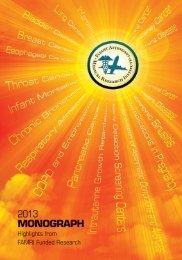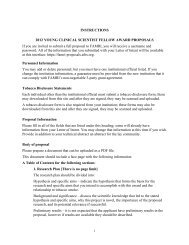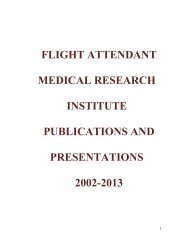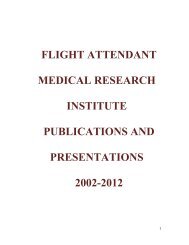MISSION
2009 compendium of FAMRI-supported research - Flight Attendant ...
2009 compendium of FAMRI-supported research - Flight Attendant ...
You also want an ePaper? Increase the reach of your titles
YUMPU automatically turns print PDFs into web optimized ePapers that Google loves.
were sequenced from NSCLC tissue and matched normal tissue. Somatic mutations of the estrogen<br />
growth factor receptor (EGFR) gene were found in 15 out of 58 unselected tumors from Japan and 1 out<br />
of 61 from the United States. Treatment with the EGFR kinase inhibitor gefitinib caused NSCLC<br />
regression more frequently in Japan, as well as in certain US cancer samples with EGFR gene mutations.<br />
The results suggested that EGFR gene mutations might predict sensitivity to gefitinib. It may be necessary<br />
to consider the power of clinical trials to identify differences within ethnic subgroups rather than assume<br />
equality in responses to drug therapies.<br />
ROLE OF ALDEHYDE DEHYDROGENASES IN THE PATHOGENESIS AND BIOLOGY OF LUNG CANCER<br />
Jan Moreb, MD; University of Florida; CIA 2003<br />
Dr. Moreb demonstrated that the enzymes aldehyde dehydrogenase (ALDH)1A1 and ALDH3A1 are<br />
highly expressed in squamous cell lung cancer (SCCA), adenocarcinoma (AdenoCA), and NSCLC, while<br />
very little expression can be detected in SCLC. Atypical pneumocytes demonstrated significantly higher<br />
levels of expression of ALDH-1A1 and ALDH-3A1 than normal pneumocytes, the normal counterpart of<br />
AdenoCA, which is suggestive of upregulation during malignant transformation to AdenoCA. On the<br />
other hand, similar levels of expression were observed in bronchial epithelium, the normal counterpart of<br />
SCCA. Cigarette smoking results in significantly increased expression of these enzymes in normal<br />
pneumocytes. Small interfering RNAs were shown to specifically inhibit ALDH-1A1 or ALDH-3A1 and<br />
result in increased 4-hydroperoxycyclophosphamide toxicity in the A549 lung cancer cell line. An Aldefluor<br />
assay was adapted successfully to measure ALDH activity in lung cancer cells and provided real-time<br />
changes in ALDH activity in viable cells treated with siRNA or chemotherapy. Lentiviral vectors had great<br />
efficacy and specificity in the inhibition of either enzyme. Differences in gene transcription were<br />
determined between wild-type A549 cells and lenti 1+3 cells and a number of genes were categorized that<br />
are either repressed or induced two-fold when compared with the wild-type cells.<br />
FAMRI Supported Publications<br />
Moreb JS, Gabr A, Vartikar GR, Gowda S, Zucali JR, Mohuczy D. Retinoic acid down regulates aldehyde<br />
dehydrogenase and increases cytotoxicity of 4-hydroperoxycyclophosphamide and acetaldehyde. J<br />
Pharmacol Exp Ther 2005;312:339-345.<br />
IDENTIFICATION OF NEW MOLECULAR TARGETS IN LUNG CANCER<br />
Pierre P. Massion, MD; Vanderbilt University; CIA 2003<br />
Dr. Massion and collaborators identified molecular abnormalities in invasive and preinvasive lung<br />
cancers. Their aims were 1) to identify amplified and deleted genomic regions in invasive squamous,<br />
adeno, large, and small cell lung cancers using array-comparative genomic hybridization; 2) to identify<br />
potential targets in preinvasive lung cancer using matrix-assisted laser desorption/ionization mass<br />
spectrometry; and 3) to clinically validate candidate genes and proteins associated with lung cancer. They<br />
characterized eight tissue microarrays from a total of 360 lung cancers for validation of biomarkers in a<br />
high-throughput fashion.<br />
FAMRI Supported Publications<br />
Gonzalez AL, Roberts RL, Massion PP, Olson SJ, Shyr Y, Shappell SB. 15-lipoxygenase-2 expression in<br />
benign and neoplastic lung: an immunohistochemical study and correlation with tumor grade and<br />
proliferation. Hum Pathol 2004;35:840-849.<br />
Massion PP, Taflan PM, Rahman SM, Yildiz P, Shyr Y, Edgerton MR, Westfall MD, Roberts JR, Pietenpol<br />
JA, Carbone DP, Gonzalez AL. Analysis of p63 in lung tumorigenesis. Cancer Res 2003;7113-7121.<br />
Massion PP, Taflan PM, Rahman SM, Yildiz P, Shyr Y, Carbone DP, Gonzalez AL. Role of p63<br />
amplification and overexpression in lung cancer development. Chest 2004;125 (5 Suppl):102S.<br />
Massion PP, Taflan PM, Shyr Y, Rahman SM, Yildiz P, Shakthour B, Edgerton ME, Ninan M, Andersen<br />
JJ, Gonzalez AL. Early involvement of the phosphatidylinositol 3-kinase/Akt pathway in lung cancer<br />
progression. Am J Respir Crit Care Med 2004;170:1088-1094.<br />
Rahman SM, Shyr Y, Yildiz PB, Gonzalez AL, Li H, Zhang X, Chaurand P, Yanagisawa K, Slovis BS,<br />
Miller RF, Ninan M, Miller YE, Franklin WA, Caprioli RM, Carbone DP, Massion PP. Proteomic<br />
patterns of preinvasive bronchial lesions. Am J Respir Crit Care Med 2005;172:1556-1562.<br />
Wardwell NR, Massion PP. Novel strategies for the early detection and prevention of lung cancer. Semin<br />
Oncol 2005;32:259-268.<br />
1 2 0 P A G E







